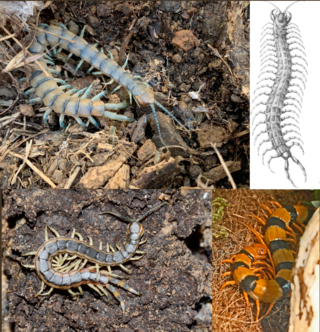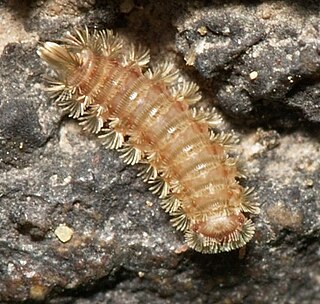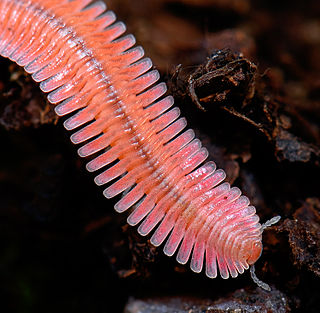
Lithobius is a large genus of centipedes in the family Lithobiidae, commonly called stone centipedes, common centipedes or brown centipedes.

The Machilidae are a family of insects belonging to the order Archaeognatha. There are around 250 described species worldwide. These insects are wingless, elongated and more or less cylindrical with a distinctive humped thorax and covered with tiny, close-fitting scales. The colour is usually grey or brown, sometimes intricately patterned. There are three "tails" at the rear of the abdomen: two cerci and a long central epiproct. They have large compound eyes, often meeting at a central point. They resemble the silverfish and the firebrat, which are from a different order, Zygentoma.

Lepismatidae is a family of primitive wingless insects with about 190 described species. This family contains the two most familiar members of the order Zygentoma: the silverfish and the firebrat. It is one of five families in the order Zygentoma.

Ctenolepisma is a genus of primitive insects in the order Zygentoma, closely related to the silverfish and firebrat but less reliant on human habitation, some species being found both indoors and outdoors and some found exclusively outdoors. The genus is distributed nearly worldwide in warm regions. Australia lacks native Ctenolepisma, but is home to introduced species.

The Margarodidae or ground pearls are a family of scale insects within the superfamily Coccoidea. Members of the family include the Polish cochineal and Armenian cochineal and the original ground pearl genus, Margarodes. Beginning in 1880, a number of distinct subfamilies were recognized, with the giant coccids being the first. Although Maskell proposed a new family, many continued to regard the monophlebids as a mere subfamily for many years, and the Margarodidae classification continued to be polyphyletic through the 20th Century. Since then, taking the advice of Koteja several subfamilies and tribes have been elevated into their own families such as Matsucoccidae and Xylococcidae. The pared-down family of Margarodidae is monophyletic.

Scolopendra is a species-rich genus of large tropical centipedes of the family Scolopendridae.

Polydesmida is the largest order of millipedes, containing approximately 3,500 species, including all the millipedes reported to produce hydrogen cyanide (HCN). Polydesmids grow and develop through a series of moults, adding segments until they reach a fixed number in the adult stage, which is usually the same for a given sex in a given species, at which point the moulting and the addition of segments and legs stop. This mode of development, known as teloanamorphosis, distinguishes this order from most other orders of millipedes, which usually continue to moult as adults, developing through either euanamorphosis or hemianamorphosis.
Ophionyssus is a genus of bird mites in the family Macronyssidae. There are about seven described species in Ophionyssus.
Cyrtodesmidae is a family of millipedes. Shear (2011) recognised the group as containing 30 species in 3 genera, probably Agnurodesmus Silvestri, 1910, Cyrtodesmus Gervais in Walckenaer, 1847, and Oncodesmella Kraus, 1959, although other authors recognise different components.

Polyxenida is an order of millipedes readily distinguished by a unique body plan consisting of a soft, non-calcified body ornamented with tufts of bristles – traits that have inspired the common names "bristly millipedes" or "pincushion millipedes". There are at least 86 species in four families worldwide, and are the only living members of the subclass Penicillata.

Polyxenidae is a family of millipedes in the order Polyxenida containing approximately 47 species in 19 genera. Adults in all species in this family have 13 pairs of legs.

Polyzoniida is an order of millipedes in the subterclass Colobognatha containing three families and at least 74 described species.

Platydesmida is an order of millipedes containing two families and over 60 species. Some species practice paternal care, in which males guard the eggs.

Chordeumatida is a large order of millipedes containing some 1200 species with a nearly worldwide distribution. Also known as sausage millipedes, they grow and develop through a series of moults, adding segments until they reach a fixed number in the adult stage, which is usually the same for a given sex in a given species, at which point the moulting and the addition of segments and legs stop. This mode of development, known as teloanamorphosis, distinguishes this order from most other orders of millipedes, which usually continue to moult as adults, developing through either euanamorphosis or hemianamorphosis.
Bollmania is a genus of millipedes with around six species occurring from Central through East Asia, including Iran, Pakistan, Tajikistan, and China. The genus was established by entomologist Filippo Silvestri in 1896, and is named in honor of Charles Harvey Bollman. Bollmania is the sole genus of the family Caspiopetalidae.
Mesomachilis is a genus of jumping bristletails in the family Machilidae. There are about six described species in Mesomachilis.
Pedetontus is a genus of jumping bristletails in the family Machilidae. There are about 10 described species in Pedetontus.
Siphonophora is a genus of millipedes belonging to the family Siphonophoridae.

Cryptops sometimes known as cave centipedes, is a centipede genus in the family Cryptopidae; species records have a world-wide distribution.
Paralamyctes is a genus of centipedes in the family Henicopidae. It was described by British zoologist Reginald Innes Pocock in 1901.












